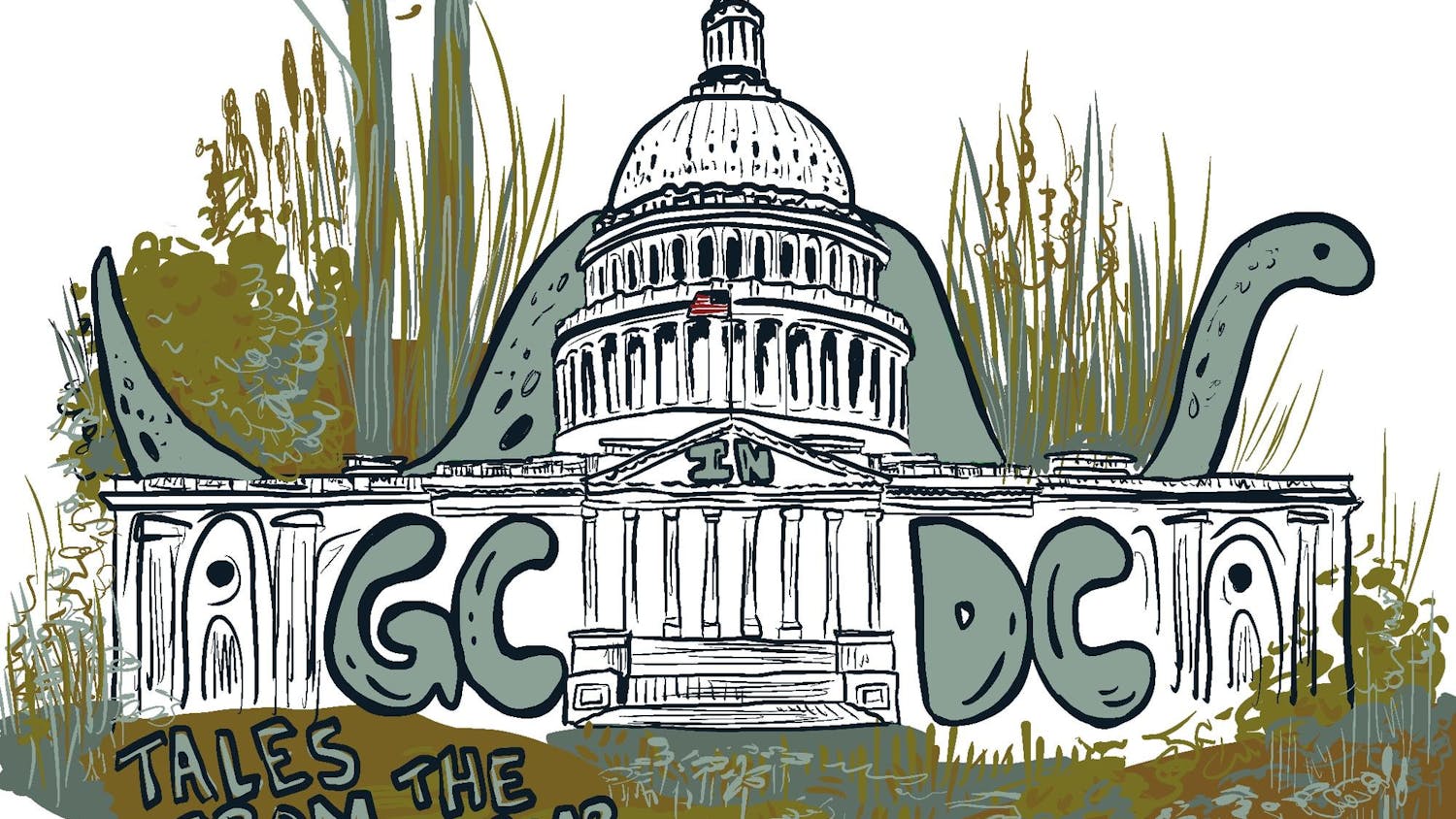In November of 1969, outraged that a company with discriminatory hiring policies was contracted to build a new dorm (now Lewis Hall), Tufts students organized demonstrations at the construction site, demanding equal employment opportunity for minority construction workers. This Nov. 5 marked the 45th anniversary of the protest.
According to Daniel Coleman (A ’73), who was a freshman and one of the protest leaders at that time, the protest was triggered by a lack of minority construction workers on the project.
“It came to our attention when a white student posted a number of things around campus [that] said 'why no blacks at Jackson Hall dormitory construction site?'” Coleman said. “So I made contact with him ... and he explained to us ... that the blacks, it appeared, [had] been banned [from] a lot of parts of the workforce for building that new dormitory.”
According to University Professor Sol Gittleman, who served on the Committee of Student Life at that time, the construction industry was controlled by unions that were mainly white, which was a main reason motivating the students to take action.
“Tufts had no control of the unions, and if we didn’t use the unions, we could not get this building built,” he said. “The unions in Boston … were well-known Irish, and very heavily Catholic … There were no black members and no Latino members. Black students got into the unions and couldn't become apprentices."
It was this lack of diversity that galvanized the protests, according to Gittleman.
"Students suddenly decided that it was the 60s already, and things were really blown-up around the country that they were gonna do something about it,” he said.
The Tufts Observer, which was published as a weekly newspaper at the time, documented the issue as it progressed. The protest first appeared in the Observer on Oct. 3, 1969, in an article titled “Afros Urge Tufts to Challenge Discrimination.”
As those concerns were ignored, the construction dispute soon evolved into a conflict between the students and Tufts administration, according to Phil Primack (A’70), the Observer's Editor-In-Chief at the time.
“Basically, the protest was aimed at Tufts administration for what the Afro-American Society saw as the administration’s failure to make the contractor honor its hiring agreements,” Primack said. “It wasn’t just the Tufts Afro; it was several Afro-American societies from several campuses. Tufts became the big test case.”
According to an article in the Observer published on Nov. 6, 1969, around 200 students from Tufts, Harvard, Boston College and other universities in the area came to the Nov. 5 protest at the construction site, which caused a work stoppage.
At that time, Coleman’s biggest concern was to focus the demonstrations focused on the goal of getting more black workers hired.
“My biggest concern was [to] make sure that we had demonstrations orient operations that would try to increase the number of blacks on the job,” he said. “That meant keeping the university [pressuring] the company, who pressured the unions to allow blacks to join the workforce at the site.”
In response to the protest, the university obtained a restraining order “against civil commotion and halting of construction progress on the site,” according to the Nov. 6 Observer article.
Occupying the work site, the students were confronted by the white construction workers worried about losing their pay for the day, according to the Nov. 6 article. Gittleman described the protest scene.
“So [the students] occupied the site, sitting or standing all over the place," he said. "It was half-built, or third-built … The workers showed up in the truck, and … they were ready to start the construction work again, and they stayed. And it looked like there was going to be trouble.”
According to Gittleman, Tufts faculty tried to get in between the students and workers in order to protect the students' safety.
“The Office of Student Life got together in a house on the corner of Packard Ave. and Powderhouse, and we had to get out there, and I thought we were gonna get our heads broken,” he said. “Our primary concern was to keep the students from getting their heads broken. The unions would have no hesitation to break their heads with a pipe.”
In addition, Tufts administration called on riot police to intervene, according to a Nov. 7, 1969 article in the Observer. After the arrival of the police, the demonstration moved to University President Burton Hallowell’s office to demand that 20 percent of the workers on site be "black or third-world workers."
As the negotiations between the demonstrators and the administration went on, an agreement was reached, and a “Memorandum of Understanding” was published in the Nov. 14, 1969 issue of the Observer. This included a proposal to have a student hired by Tufts to monitor the employment of minority workers on the site.
According to the Nov. 14 article, this understanding halted the protests, and brought two black bricklayers to the construction site. Eventually, Tufts filed a lawsuit against the company for its non-compliance with federal law in equal opportunity hiring.
Coleman believes that the protest reached its goals, and that its effects were felt at other universities in the Boston area. Eventually, having black construction workers became a necessity, he said, if protests were to be avoided.
“Not only did we increase the number of blacks at the construction site over a few months, but ... in the construction at the Tufts Medical Center … an increased number of blacks were there [as a result]” he said. “Then it was a constant movement where all the universities in the area came ... to have had blacks on the site. ... All of a sudden, having blacks there has been important to induce non-protest... [at] the universities.”
Primack went further, arguing that the protest signified the incorporation of the economic side of social activism into the civil rights movement of the 60s.
"Until this action, most of the demonstrations involving race on the Tufts campus were about more scholarships, more recruitment," he said. "It basically involved students advocating for students ... This demonstration linked the social activism of the day to real economic needs of people who were not necessarily part of Tufts. That mattered then and now.”
However, Professor Antonia Chayes, who was the Dean of Jackson College at that time and the administrative representative during the protest, doesn't share Primack and Coleman's positive view of the events.
“I don’t think the protest was effective, I think it was extremely dangerous,” Chayes said. “In the very turbulent time, there [was] a lot of violence … I think they were essentially not very smart because what they were protesting … [was] the ratio makeup of the unions that were building the hall. That had nothing to do with the school. So it was just interesting to protest.”
At the same time, she was also disappointed by the Tufts administration’s response of calling in the police, because it might have instigated violence.
“I was angry at the way the administration had responded," she said. "We managed to successfully work it through, because Massachusetts is not Kent state... [but] it was inflammatory and stupid on the part of the students, and even more so on the part of the administration."
Primack believes that the protest still has meaning for current Tufts students, as today's issue of income inequality echoes the problems that initiated the demonstration in 1969.
“This [protest] directly, 45 years later, relates to income inequality, today’s big issue, because [that's] what the demonstrations by the Afro-American Society were: The construction jobs were jobs that paid well, and ... if you ever wanted to have black people have economic opportunity, they need access to those jobs."
Chayes, on the other hand, thinks that the protest has lost its relevance as relations between the student body and the administration have changed.
“One of the interesting [things is] to contrast that with one of the issues today and how the students dealt with them," she said. "The atmosphere was much more volatile in those days, and the administrations have learned a great deal [about] how to behave."
According to Chayes, the protests don't imply that today's students will or should take action in the same way.
"I think the issues [that] happened in the [1960s] are really not very relevant to the students today," she said. "Those … things [that] happened to their parents, or grandparents, are interesting historically. But they don’t represent a model for how students should behave today.”





